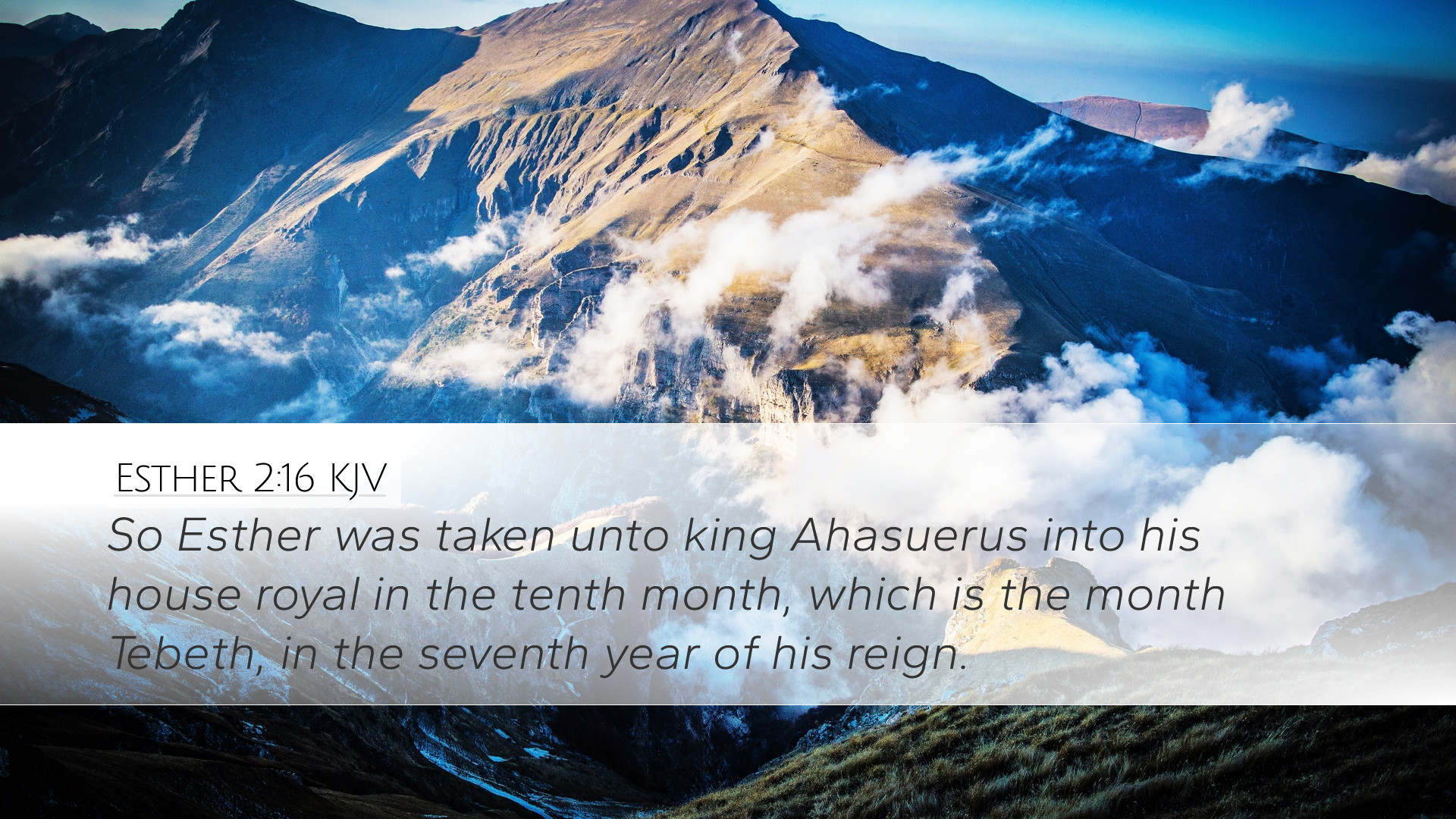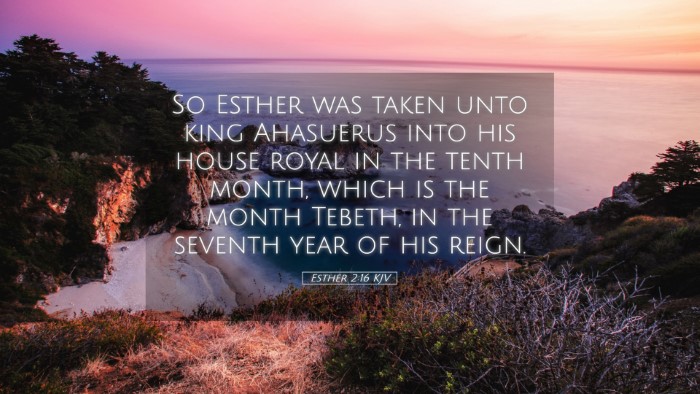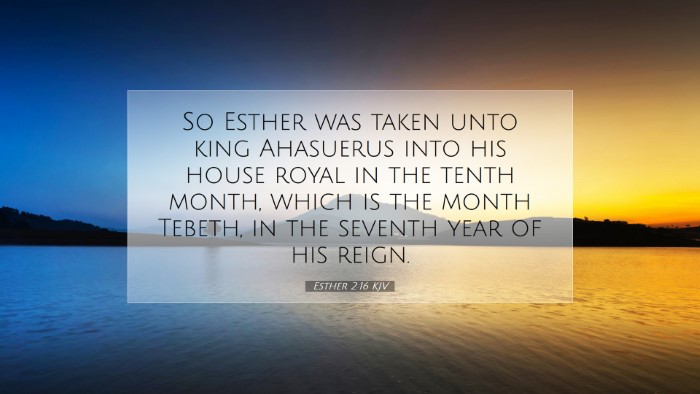Old Testament
Genesis Exodus Leviticus Numbers Deuteronomy Joshua Judges Ruth 1 Samuel 2 Samuel 1 Kings 2 Kings 1 Chronicles 2 Chronicles Ezra Nehemiah Esther Job Psalms Proverbs Ecclesiastes Song of Solomon Isaiah Jeremiah Lamentations Ezekiel Daniel Hosea Joel Amos Obadiah Jonah Micah Nahum Habakkuk Zephaniah Haggai Zechariah MalachiEsther 2:16
Esther 2:16 KJV
So Esther was taken unto king Ahasuerus into his house royal in the tenth month, which is the month Tebeth, in the seventh year of his reign.
Esther 2:16 Bible Commentary
Commentary on Esther 2:16
Esther 2:16 states, "So Esther was taken unto king Ahasuerus into his house royal in the tenth month, which is the month Tebeth, in the seventh year of his reign." This verse marks a pivotal moment in the narrative of Esther, encapsulating both the transition of Esther from a humble background to a position of influence and the providence of God at work in the unfolding history of His people.
Contextual Overview
The story of Esther is set during the reign of Ahasuerus (commonly believed to be Xerxes I of Persia), who ruled from 486 to 465 B.C. The selection of Esther as queen arises against a backdrop of political intrigue and moral challenges. In this context, Esther's ascent is not merely a personal triumph; it signifies the unfolding plan of God regarding His covenant people.
The Significance of Esther’s Selection
Esther's selection as queen is richly layered with implications:
- Divine Providence: Scholars such as Matthew Henry emphasize God’s guiding hand throughout Esther’s life, leading her from obscurity to royalty, even in the face of societal challenges. His commentary highlights how Esther's rise corresponds with God's covenant commitment to Israel.
- Cultural Reflection: Albert Barnes points out the cultural dynamics at play as Esther enters the royal palace, showcasing the Persian court's opulent and often morally ambiguous society. This contrast serves to highlight Esther’s character and courage.
- Historical Role: Adam Clarke elaborates on the historical implications, suggesting that Esther's elevation is integral to the deliverance of the Jewish people, which will unfold later in the narrative. Her femininity and strength in a patriarchal society add a layer of depth to her role as queen.
The Month of Tebeth
The mention of the tenth month, Tebeth, holds significance both chronologically and symbolically:
- Chronological Timing: The timing of Esther's installation as queen in the seventh year of Ahasuerus' reign suggests a period of consolidation after the king's earlier conflicts, thereby setting a stage for the events to come.
- Spiritual Symbolism: According to Jewish tradition, Tebeth corresponds with divine intervention. This can foreshadow the upcoming struggles and triumphs for the Jewish people as conveyed through spiritual commentators.
Theological Reflections
This passage opens a window into various theological themes:
- God’s Sovereignty: The overarching theme of God’s sovereignty in Esther manifests as He places Esther in a position to influence the fate of His people. Both Barnes and Henry reflect on the notion that, despite His name being absent from the text, God’s hand is palpably guiding the events.
- Human Agency and Divine Will: Esther's choice to willingly enter the palace emphasizes the balance between divine providence and human agency. It raises questions of ethical implications and wise decision-making.
Practical Applications for Today
The insights from Esther 2:16 carry practical implications:
- In Times of Transition: For pastors and students, this passage serves as an encouragement to trust in God’s placement during transitional phases of life. The significance of being in the right place at the right time mirrors the calling believers experience.
- Courage Amid Adversity: Esther's example of courage and compliance models how believers can act faithfully in the face of daunting challenges, an essential lesson for theologians studying the complexities of faith in secular environments.
- Influence and Responsibility: This verse challenges today's leaders to recognize the weight of their influence and the responsibility that accompanies it, echoing the biblical mandate to act with integrity and foresight.
Conclusion
Esther 2:16 is a vital component in understanding the narrative of Esther and the overarching themes of divine providence and human courage. By synthesizing insights from well-known public domain commentaries, we uncover a richer understanding that serves both theological inquiry and practical application. The story of Esther reminds us that God guides the journeys of His people, often in unexpected ways, bringing forth His plans for deliverance and redemption.


